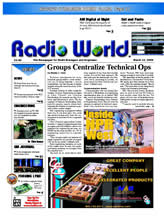
 |
|
|||||||||
|
|
 |
||||||||
 |
A Satellite Down Converter Tool by Mark Persons |
Radio World Article October 22, 2003 |
| If you are fortunate enough to own an RF spectrum
analyzer but are not blessed with one that goes above 1 GHz to look at satellite
transponders, I may have an almost-free solution to your problem. An opportunity presented itself recently when a local station was going to "throw out" a Scientific Atlanta Encore DSR-3610 Digital Satellite Receiver. This $3,000 unit was made in 1997 and now is obsolete. However, it has a programmable synthesized local oscillator and down converter onboard to convert L Band (950-1450 MHz) input to a 70 MHz IF (Intermediate Frequency). It is only one rack unit (1-3/4 inches high) so there is no difficulty hauling it around. The receiver appears to be essentially the same as the Encore AD4595 used for ABC. Jerry Weddle at Harris Broadcast is familiar with satellite receivers. He connected me, via a telephone conference call, to Buzz Bednar of Starguide Digital Networks. His help enabled me to find a point to sample the 70 MHz on the main board in the receiver. It is test point TP336. Because the receiver is not capable of decoding the current digital scheme, the front-panel headset jack is useless. I removed the headset jack and put a BNC panel jack in its place. No metalwork was required because the headset jack and the BNC jack use the same 3/8-inch diameter hole. I ran a short piece of RG-58A/U 50 -- ohm coaxial cable from TP336 to the front -- panel jack. Just to make sure that no DC voltage would ever appear on the coaxial cable and the connected spectrum analyzer, I inserted a small .01 mfd/50 volt ceramic dip capacitor in series with the center conductor of the cable where it connects to the circuit card. This was all that was required to modify the receiver. Putting it to use It didn't take long before a client called to say, "Help me with a new satellite dish installation." The new test equipment setup was a big help in finding the satellite. The satellite transponder was visible at 70 MHz. Because the digital signals look like noise on a spectrum analyzer, there is no distinctive shape to look for. Analog video has a definite look. One great attribute of the Encore receiver is that the transponder can be chosen by front-panel controls. Push "Set Xpndr," then use the up and down arrow keys, followed by "Enter." Another nice feature of the Encore is a jumper plug on the back with the option of powering an LNB on the dish. I am still learning my way through this one; but initial results are good. I hope this hint will allow you to increase your test equipment inventory for next to nothing. After all, you can never have too much test equipment. Another inexpensive satellite locating tool has become available recently. It is a small box with an analog signal strength meter. You connect it in series with the 75-ohm line at the satellite dish LNB output. Marketed as the PG-753 Satellite Finder Kit, I purchased one for about $40 as a closeout item from MCM Electronics. Friends tell me that other companies have them, too. The meter is great for initially finding a satellite. It even comes with a military-style compass for getting the dish pointed to the right part of the sky. As for fine-tuning on a digital satellite transponder, the best tool is the EBNO indication on the receiver that the station will be getting audio from. Adjusting for maximum signal strength can be a misleading indicator. You could be peaking on a strong carrier on a transponder of the opposite polarization. Use EBNO to adjust azimuth, elevation and polarization to get the best possible performance. I recommend you do this even if the satellite receiver is happy when you are there. If you don't do your best, it could go out of stable lock when the weather turns poor. In fact, I like to "shake" the dish to see how it performs. A windy day could easily create that condition and cause problems you might not otherwise see when you are there.
|
| See you down the road. I'll leave the soldering
iron on for you. Mark Persons, W�MH, is certified by the Society of Broadcast Engineers as a Professional Broadcast Engineer and has more than 30 years experience. Visit www.mwpersons.com From the Radio World October 22, 2003 issue http://www.rwonline.com http://www.rwonline.com/reference-room/special-report/04_rwf_persons.shtml
|
|
Questions? Email Mark Persons: teki@mwpersons.com |
|
.